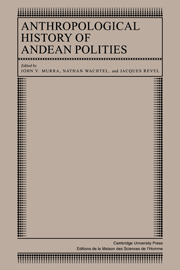Book contents
Part I - Ecology and society
Published online by Cambridge University Press: 05 October 2010
Summary
The Andean environment would seem to pose insurmountable difficulties for man, for it consists of one of the most arid coastal deserts in the world, of high plateaus that are cold and dry, and of vertiginously steep Amazonian slopes. Yet its inhabitants have used its resources in such a way that they have managed not only to survive but also to create a series of civilizations that confer upon the Andes, for all their diversity, a remarkable cultural unity. Even the most isolated valleys have been open, sometimes repeatedly in the course of millennia, to external influences. Thus archaeologists have come across objects of Chavin, Tiwanaku, or Inka origin some hundreds of kilometers from their place of manufacture, along with remains from the local tradition.
In this first part of the volume, Olivier Dollfus analyzes the diversity of Andean environments through both time and space, and Ana Maria Lorandi examines the factors that seem to account for the spread of the three great “horizons” that succeeded each other before the European invasion. These two essays complement the article by Lautaro Núñez, who evokes the destiny of the Tarapacá Valley over what turns out to be truly a long haul (from 6,000 B.C. to our day). The ecological circumstances of this valley, located today in northern Chile, were perceived and rated in the most varied ways by the many societies that have succeeded each other: The successive changes in the settlement pattern and in the awareness of potential resources are witness to the multiplicity of possible solutions and to their originality.
- Type
- Chapter
- Information
- Anthropological History of Andean Polities , pp. 9 - 10Publisher: Cambridge University PressPrint publication year: 1986



